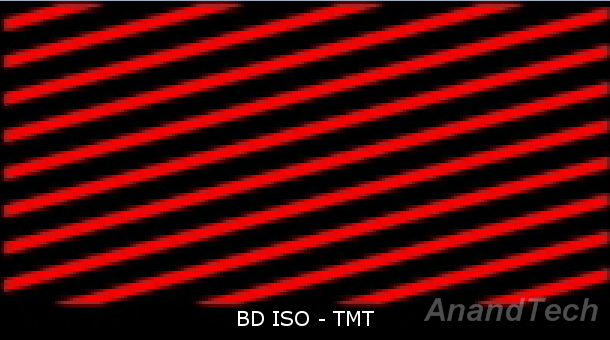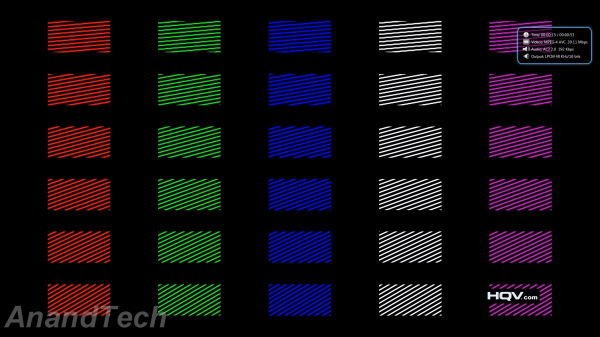AMD Radeon HD 7750 & Radeon HD 7770 GHz Edition Review: Evading The Price/Performance Curve
by Ryan Smith & Ganesh T S on February 15, 2012 12:01 AM EST- Posted in
- GPUs
- AMD
- HTPC
- GCN
- Radeon HD 7000
HQV 2.0 Benchmarking
HTPC enthusiasts are often concerned about the quality of pictures output by the system. While this is a very subjective metric, we have decided to take as much of an objective approach as possible. Over the last year or so, we have been using the HQV 2.0 benchmark for this purpose.
The HQV 2.0 test suite consists of 39 different streams divided into 4 different classes. The playback device is assigned scores for each, depending on how well it plays the stream. Each test was repeated multiple times to ensure that the correct score was assigned. The scoring details are available in the testing guide on the HQV website.
We first played back the benchmarking clips off the Blu-ray, but the scores recorded below are for standalone M2TS playback using CyberLink PowerDVD 12. Our take is that it is standalone files (such as those taken using consumer camcorders and smartphones) which require video post processing more than the already carefully transferred Blu-ray content. If certain driver post processing features are available only for Blu-ray playback, then, it is as good as not being available for consumers to take advantage.
In the table below, we indicate the maximum score possible for each test, and how much the 7750 was able to get with AMD's Catalyst 12.1-based launch drivers.
| AMD 7750 : HQV 2.0 Benchmark | ||||
| Test Class | Chapter | Tests | Max. Score | Radeon HD 7750 |
| Video Conversion | Video Resolution | Dial | 5 | 5 |
| Dial with Static Pattern | 5 | 5 | ||
| Gray Bars | 5 | 5 | ||
| Violin | 5 | 5 | ||
| Film Resolution | Stadium 2:2 | 5 | 5 | |
| Stadium 3:2 | 5 | 5 | ||
| Overlay On Film | Horizontal Text Scroll | 5 | 5 | |
| Vertical Text Scroll | 5 | 5 | ||
| Cadence Response Time | Transition to 3:2 Lock | 5 | 5 | |
| Transition to 2:2 Lock | 5 | 5 | ||
| Multi-Cadence | 2:2:2:4 24 FPS DVCam Video | 5 | 5 | |
| 2:3:3:2 24 FPS DVCam Video | 5 | 5 | ||
| 3:2:3:2:2 24 FPS Vari-Speed | 5 | 5 | ||
| 5:5 12 FPS Animation | 5 | 5 | ||
| 6:4 12 FPS Animation | 5 | 5 | ||
| 8:7 8 FPS Animation | 5 | 5 | ||
| Color Upsampling Errors | Interlace Chroma Problem (ICP) | 5 | 2 | |
| Chroma Upsampling Error (CUE) | 5 | 2 | ||
| Noise and Artifact Reduction | Random Noise | SailBoat | 5 | 5 |
| Flower | 5 | 5 | ||
| Sunrise | 5 | 5 | ||
| Harbour Night | 5 | 5 | ||
| Compression Artifacts | Scrolling Text | 5 | 5 | |
| Roller Coaster | 5 | 5 | ||
| Ferris Wheel | 5 | 5 | ||
| Bridge Traffic | 5 | 5 | ||
| Upscaled Compression Artifacts | Text Pattern | 5 | 3 | |
| Roller Coaster | 5 | 3 | ||
| Ferris Wheel | 5 | 3 | ||
| Bridge Traffic | 5 | 3 | ||
| Image Scaling and Enhancements | Scaling and Filtering | Luminance Frequency Bands | 5 | 5 |
| Chrominance Frequency Bands | 5 | 5 | ||
| Vanishing Text | 5 | 5 | ||
| Resolution Enhancement | Brook, Mountain, Flower, Hair, Wood | 15 | 15 | |
| Video Conversion | Contrast Enhancement | Theme Park | 5 | 5 |
| Driftwood | 5 | 5 | ||
| Beach at Dusk | 5 | 5 | ||
| White and Black Cats | 5 | 5 | ||
| Skin Tone Correction | Skin Tones | 10 | 7 | |
| Total Score | 210 | 193 | ||
We were not able to match what AMD claimed. In all probability, the difference is in the chroma upsampling scores. We already covered this in the Llano review. To recap, the image below is a screen capture while playing the HQV benchmark clip from a Blu-ray ISO on the AMD A8-3850. Note that the light red fringes along the edgs are uniform and extend to the right and the left before tapering off.

Now, let us look at the screen capture when the M2TS is played back using PowerDVD 12 on the Radeon HD 7750.
Zoom into the red stripes on the third row (in the original screenshot) and you can see for yourself that we have some ghost samples extending above and below the actual line of pixels. The screenshot is not at the exact timestamp as that of the Llano sample reproduced above, but the reader should be able to get a general idea of the problem we are hinting at. Readers interested in finding out more about the source of this problem should read up this excellent piece to get more information.
We notified AMD about this issue during the Llano review, but action doesn't seem to have been taken even after 6 months on what is clearly a driver issue. Note that we are not using MPC-HC (which might introduce its own errors in the renderer) in this case, but a standard off-the-shelf commercial player in CyberLink PowerDVD 12. Hopefully, AMD wakes up to this issue soon.











155 Comments
View All Comments
Dianoda - Wednesday, February 15, 2012 - link
Yeah, I jumped on that BB/Visiontek HD4850 512MB deal as well. Bought the card about a week before the official launch and at a $50 discount on top of that. Timing was perfect, too, as I had just finished my build, short one video card (borrowed a 3850 from a friend for a few weeks).I finally upgraded from that card to a 6950 2GB (BIOS modded to 6970) about a month ago - Skyrim was just too much for the 4850 to handle @ 2560x1440. The 6950 2GB is a great card for the price if you're willing to perform the BIOS mod (and don't mind rebate forms).
nerrawg - Thursday, February 16, 2012 - link
Exactly! I bought 2 4850's in the UK in 2009 for £65 ($95) each - best GPU purchase I have made in 12 years! I now have a single 6870 that I bought in 2011 for £120- but its not really an upgrade at all. Thought I would wait and get a second one cheaper but now I don't think that will happen2008-2009 was the sweet spot of a decade for Desktop GPUs. The way things are going with the Desktop (AMD bullsnoozer etc. etc.) I fear that it might have even been the sweet spot of GPU performance for the decade to come as well. I would love to see some massive progress in graphics, but it seems that the all the "suites" care about now days is "smart" this and "smart" that. I can't really blame them either, because until pc programmers get their act together and actually start making apps and games that push what is possible on current hardware I don't see any reason why I need 2X the GPU and CPU compute power every 1-2 years.
Come on guys - we are all waiting for the next "Crysis" - if it doesn't come then it might spell the end of the enthusiast desktop
StrangerGuy - Wednesday, February 15, 2012 - link
AMD having a fail product at $160 that couldn't even beat an almost 1.5 year old $150 6870 isn't surprising considering they are also the ones with the cheek to price their FX-8150 at near 2600K prices.thunderising - Wednesday, February 15, 2012 - link
The only problem I have with AMD on this card is WHY THE LOW BANDWIDTH.The card performs nearly 10% faster when the memory is clocked at 6GHz QDR (TPU reviews) and 15% with Core Clock matching XFX's OCed Speed.
I think that 6GHz memory modules would have taken the HD7770 a long way ahead. The performance boost would have been enough to hit HD6850 performance, or beat it in all cases, and at that point, this card at 159$ would make sense.
Right now, until the price hits about 129$, this doesn't make sense.
chizow - Wednesday, February 15, 2012 - link
But you get GCN, 28nm and a bottle of verdetard?Zoomer - Wednesday, February 15, 2012 - link
GCN is worse than useless for gamers and non compute users.jokeyrhyme - Wednesday, February 15, 2012 - link
I think I've built my last system with an AMD CPU. Intel completely abused their monopoly and decimated AMD's success in the CPU department, and I don't think AMD will have an enthusiast-quality CPU ever again. :(That said, I think I will still use AMD GPUs for a while yet.
nVidia's Kepler may beat AMD later this year, but AMD actually has an open-source driver developer on staff and routinely publishes hardware documentation. AMD GPUs will probably have better support for Wayland than their nVidia counterparts due to these factors. If you use Linux and want to stay on the cutting edge, then I don't think picking nVidia is particularly wise.
ganeshts - Wednesday, February 15, 2012 - link
At least in the HTPC area, NVIDIA is miles ahead of AMD in the open source support department.Almost all Linux HTPCs capable of HD playback have NVIDIA GPUs under the hood, thanks to their well supported VDPAU feature.
AMD started getting serious with xvBA only towards the end of last year, and they still have a lot of catching up to do [ http://phoronix.com/forums/showthread.php?65688-XB... ]
Ananke - Wednesday, February 15, 2012 - link
AMD is several years behind NVidia on the compute side...actually they are nowhere as of today. The AMD 7xxx series is so ridiculously priced, it will not get an user base to be attractive for developers. Actually, I am at the point of considering NVidia cards for computing, despite that I hate their heat and power consumption.AMD had their chance and they blew it.
Besides, we shall see where the AMD ex-VP will go - that company most likely will be the next big player in graphics and high performance computing. Probably Apple.
PeskyLittleDoggy - Thursday, February 16, 2012 - link
In my country, company policy dictates you cannot leave your company and work for a competing company if you have valuable R&D knowledge. Thats part of the restraint of trade clause in your contract.Basically what I'm saying is, AMD's ex-VP will not be able to work in any company with a graphics department for 2 years if the contract is similar to mine. I can't remember now but some CEO was sued for that recently.